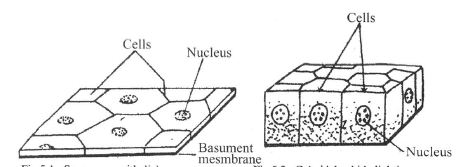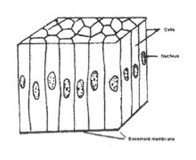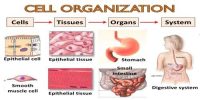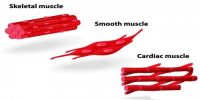On the basis of the number of cells, characteristic and the presence or absence of the intercellular materials or matrix secreted by cells, the tissue is mainly divided into four categories.
i) The Epitherlial Tissue.
ii) The Connective Tissue.
iii) The Muscular Tissue.
iv) The Nerve Tissue.
Location, Structural characteristics and Function of different types of Tissue of the Animal Body:
- Structural Characteristics, Function and Location of Epithelial Tissue: Structural Characterisics: The cells of the epithelial tissue lie closely or side by side on a basement membrane. There is no matrix in this tissue. On the basis of cell size, location in the animal body and nature of work, this tissue is of three types, such as;
- Squamous Epithelial Tissue: Cells of this tissue are flat like scales; nucleus is large (Fig-a) Example: Wall of the Bowman’s capsule of Kindey.
Function: Mainly filtration and covering.
Cuboidal Epithelial Tissue: Cells of this tissue are cuboidal, as the length, breadth and height of the cells are nearly equal (Fig-b). Example: Collecting tubules of the kidney.
Function: Mainly absorption and covering.
Columnar Epithelial Tissue: Cells of this tissue are narrow and elongated like a column (Fig-c) Example: On the internal wall of the intestine.
Function: Mainly secretion, protection and absorption.

Fig (a) Fig (b)

Fig (c)












